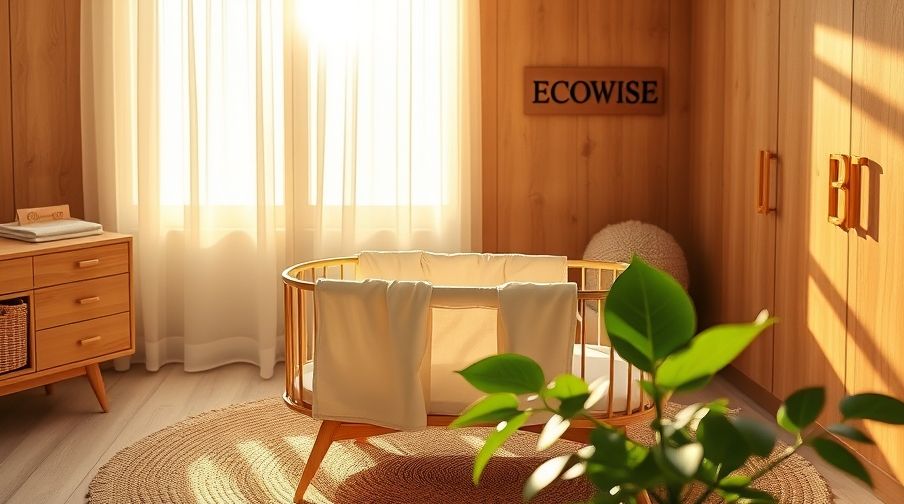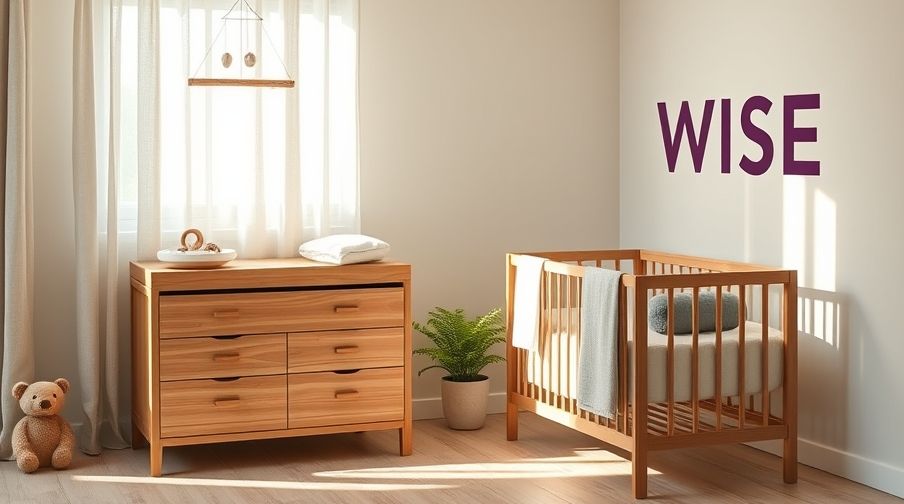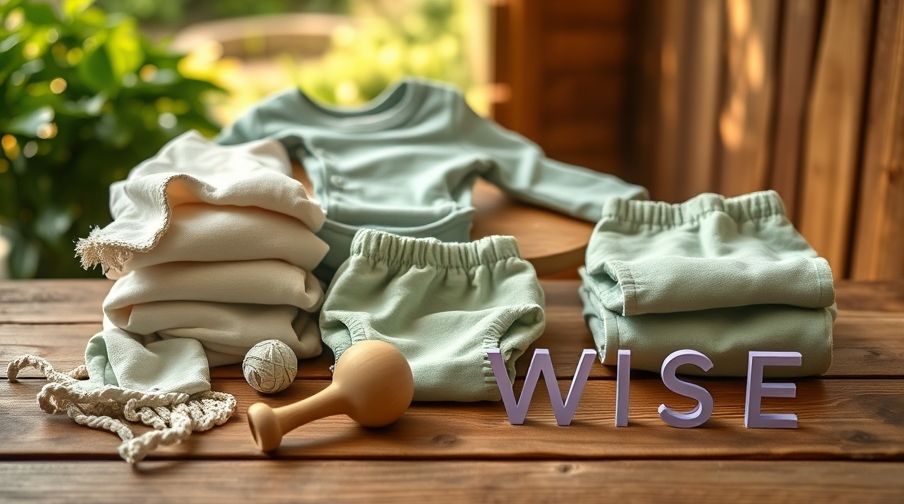Eco baby products encompass items made from sustainable, non-toxic, and ethically sourced materials, minimizing environmental impact and ensuring baby safety. Embracing green parenting tips means making conscious choices from organic baby food to non-toxic nursery setup, fostering a healthier future for your child and the planet. This guide empowers parents to raise eco-conscious kids through sustainable practices.
- Prioritize Safety & Health: Choose eco baby products to significantly reduce your baby’s exposure to harmful chemicals like phthalates, BPA, and parabens found in conventional items.
- Embrace Sustainable Practices: Adopt habits like using cloth diapers, making DIY baby care items, and buying second-hand to minimize waste and reduce your carbon footprint.
- Foster Long-Term Values: Green parenting isn’t just about products; it’s about raising eco-conscious kids who understand the importance of environmental stewardship from a young age.
- Be a Smart Consumer: Learn to spot “greenwashing” by looking for credible third-party certifications (like GOTS or OEKO-TEX) and prioritize items that offer long-term value to stay within budget.
1. Introduction & Importance
Choosing eco baby products is a crucial step for new parents committed to health and sustainability. These choices extend beyond mere purchases, influencing the environment your child grows up in and the values they will eventually learn. Understanding the “why” behind these decisions empowers you to make informed choices that benefit everyone.

Why Choose Eco Baby Products?
Opting for eco baby products significantly reduces your baby’s exposure to harmful chemicals. Many conventional items contain phthalates, BPA, and parabens, which can have detrimental effects on development. By selecting natural alternatives, you provide a safer environment for your little one.
Beyond health, the environmental benefits are substantial. Eco baby products often involve less waste, lower carbon footprints, and conserve precious natural resources. This supports ethical and sustainable businesses, contributing to a circular economy. Ultimately, it ensures a safe baby products guide for your family, promoting well-being from day one.
The Impact of Green Parenting
Green parenting creates a healthier home environment for your child, free from common pollutants and toxins. This holistic approach extends beyond products, influencing daily habits and choices. By consciously making sustainable decisions, you’re not just buying eco baby products, but actively shaping a healthier lifestyle.
Furthermore, these practices teach children about sustainability from a young age, effectively raising eco-conscious kids. They learn to appreciate resources, reduce waste, and understand their role in protecting the planet. This contribution to a more sustainable future is invaluable, setting a foundation for lifelong environmental stewardship. For more information on environmental health for children, consult resources like the EPA or CDC.
2. Top Parenting Tips Summary
Navigating the world of baby essentials can be overwhelming, but adopting green parenting tips simplifies the process. Focusing on a few core principles can make a significant difference in your journey towards sustainable parenting. This quick guide will help you prioritize and implement eco-friendly choices effectively.
Quick Guide to Sustainable Baby Care
When starting your journey with eco baby products, prioritize multi-use and durable items. This reduces the need for frequent replacements and minimizes waste over time. Think long-term value and versatility in every purchase.
Embrace natural baby care tips and DIY solutions whenever possible. Crafting your own wipes or creams not only saves money but also gives you full control over ingredients. Choose organic and natural materials for everything from clothing to bedding, ensuring fewer chemical exposures. Remember to reduce, reuse, and recycle all baby essentials, from packaging to outgrown items. Critically, focus on a non-toxic nursery setup from the very beginning to establish a healthy foundation.
3. Detailed Guidance on Each Tip
Creating a sustainable environment for your baby requires attention to detail across multiple categories. From the furniture in their room to the food they eat, every choice contributes to their well-being and the planet’s health. This section offers a comprehensive safe baby products guide.

Non-Toxic Nursery Setup Essentials
A non-toxic nursery setup is fundamental for your baby’s health and comfort. When selecting furniture like cribs and changing tables, opt for solid wood construction with low-VOC (volatile organic compound) finishes. These choices minimize the release of harmful fumes into your baby’s breathing space.
For crib mattresses, prioritize organic cotton, natural latex, or wool options. These materials are naturally flame-resistant and free from synthetic chemicals often found in conventional mattresses. For decor, choose natural fiber rugs, lead-free paints, and non-toxic wall decals. Creating a truly chemical-free nursery involves thoughtful material selection for every element.
Safe Baby Products Guide: From Diapers to Toys
Diapering is a significant area where eco-friendly choices can have a huge impact. Consider reusable cloth diapers as a sustainable alternative to conventional disposables, or choose eco-friendly disposable diapers made from plant-based materials. For wipes, opt for biodegradable wipes or reusable cloth wipes to reduce landfill waste.
When it comes to baby clothes, prioritize organic cotton, bamboo, or hemp clothing. These natural fibers are soft, breathable, and grown without harmful pesticides. For toys, select wooden toys, silicone toys, or recycled plastic toys, explicitly avoiding those containing BPA or phthalates. This comprehensive guide helps you choose the best eco friendly baby products for your nursery. Consult resources like the Environmental Working Group (EWG) for more guidance on product safety.
How to Choose Organic Baby Food
Choosing organic baby food provides significant benefits, primarily reducing your baby’s exposure to pesticides and ensuring no genetically modified organisms (GMOs). Organic farming practices also promote healthier soil and ecosystems. When purchasing, look for clear certifications like the USDA Organic seal, which guarantees adherence to strict organic standards.
You have the option of making homemade baby food using organic produce, which allows complete control over ingredients and freshness. Alternatively, many store-bought organic options are available, ranging from purees to finger foods. Always check labels carefully for hidden ingredients. For more homemade organic baby food recipes, explore our resources, and visit the USDA Organic website for detailed certification information.
DIY Baby Care & Natural Baby Care Tips
Embracing DIY baby care is an excellent way to ensure purity and save money. You can easily make a homemade baby wipes solution using filtered water, natural castile soap, and a few drops of essential oils like lavender. This avoids questionable ingredients often found in commercial wipes.
Another valuable natural baby care tip is crafting your own DIY diaper rash cream. Simple recipes often involve zinc oxide, shea butter, and coconut oil, providing effective relief with natural ingredients. For bathing, gentle, natural baby washes and lotions made from plant-based components are readily available or can be concocted at home. Making your own solutions allows for complete control over ingredients, ensuring only the safest for your little one.
Sustainable Parenting Practices Beyond Products
Sustainable parenting extends far beyond just purchasing eco baby products; it involves a shift in lifestyle and mindset. Adopting a minimalist approach to baby gear can significantly reduce consumption and clutter. Ask yourself if an item is truly essential before buying.
Embrace second-hand shopping and gratefully accept hand-me-downs. This not only saves money but also reduces demand for new production and keeps items out of landfills. Furthermore, practice energy conservation in your home and prioritize conscious consumption and waste reduction in all aspects of daily life. These actions collectively create a more sustainable future for your child.
4. Common Pitfalls
Even with the best intentions, navigating the world of eco baby products can present challenges. It’s important to be aware of common pitfalls, such as deceptive marketing tactics and budgeting considerations. Understanding these can help you make more informed and genuinely sustainable choices.
Avoiding Greenwashing
“Greenwashing” is a misleading practice where companies deceptively market products as environmentally friendly. To avoid this, be wary of vague claims like “natural” or “eco-friendly” without specific details. Instead, look for robust third-party certifications such as GOTS (Global Organic Textile Standard), OEKO-TEX, or Cradle to Cradle. These certifications indicate that products have met rigorous environmental and social standards, providing genuine assurance. Researching brands and their transparency reports can also reveal their true commitment to sustainability, helping you identify truly eco friendly baby products.
Budgeting for Eco-Friendly Choices
While some eco baby products may have a higher initial investment, they often offer long-term savings. For instance, reusable cloth diapers, while a larger upfront cost, can save hundreds of dollars compared to years of disposable diaper purchases. Prioritize essential eco baby products where the health and environmental benefits are most critical, such as crib mattresses and feeding supplies. Explore community resources, local parenting groups, and second-hand markets for gently used items. Many high-quality eco-friendly items can be found at a fraction of the cost, making sustainable parenting more accessible.
5. Tools & Product Recommendations
Equipping yourself with the right tools and knowing trusted brands makes the journey of sustainable parenting much smoother. This section will guide you toward reliable eco baby products and essential resources. Making informed choices helps ensure you’re investing in products that truly align with your green values.

Top Eco Baby Product Brands
Several brands consistently deliver on their promise of providing high-quality eco baby products and organic baby products. Consider brands like [Brand A] for their organic cotton clothing and textiles, known for exceptional softness and durability. [Brand B] specializes in non-toxic nursery furniture, offering cribs and dressers with low-VOC finishes and sustainably sourced wood. For a comprehensive safe baby products guide covering everyday essentials, [Brand C] offers a range of biodegradable diapers and plant-based wipes.
[Brand D] is excellent for eco-friendly toys made from sustainably harvested wood or recycled plastics, ensuring child safety without harmful chemicals. Lastly, [Brand E] focuses on natural baby care tips, providing gentle washes and lotions free from parabens and synthetic fragrances. These brands exemplify a strong commitment to sustainability, from sourcing to production. Explore our specific product review pages for detailed insights into these and other eco friendly baby products.
Essential Tools for Green Parents
Beyond specific products, certain tools can significantly support your green parenting journey. A high-efficiency washing machine is invaluable if you opt for cloth diapers, ensuring thorough cleaning with minimal energy and water. This is a key part of maintaining your eco baby products.
Consider composting bins for food waste, especially as your baby transitions to solids and generates organic scraps. This diverts waste from landfills and creates nutrient-rich soil. Reusable snack pouches and water bottles are also essential for on-the-go parents, reducing reliance on single-use plastics. These tools help simplify sustainable practices in daily life.
6. Eco Families Case Studies
Learning from the experiences of other families can provide inspiration and practical insights for sustainable parenting. These real-life journeys highlight both the challenges and the triumphs of integrating green parenting tips into daily life. They demonstrate that raising eco-conscious kids is achievable and rewarding.
Real-Life Journeys to Sustainable Parenting
The Johnson family, for example, successfully transitioned to cloth diapers and homemade baby food, despite initial skepticism from relatives. Their triumph lay in the significant cost savings and reduced waste they observed, proving eco baby products can be practical. Their son, now a toddler, naturally participates in sorting recycling and enjoys playing with his wooden eco-friendly toys.
The Lee family focused on creating a non-toxic nursery setup from scratch, air-purifying plants and low-VOC paints. They faced the challenge of sourcing affordable organic crib mattresses but found solutions through community marketplaces and bulk purchases. Their journey underscores the importance of a safe baby products guide and proactive research. These families, among others, show that with dedication, raising eco-conscious kids through sustainable parenting is an enriching experience.
7. Advanced Strategies
Once you’ve mastered the basics of using eco baby products and implementing green parenting tips, you might be ready to explore more advanced strategies. These steps extend your impact beyond your home, contributing to broader sustainability efforts and raising eco-conscious kids within a larger community context.
Beyond the Basics: Deeper Dives into Sustainability
Taking your sustainable parenting journey to the next level involves active participation in advocacy for eco-friendly policies. Join local environmental groups or reach out to elected officials to support initiatives that promote clean energy, waste reduction, or stricter chemical regulations. Your voice as a parent can be powerful.
Engage in community involvement, participating in local clean-up drives, community gardens, or sustainable initiatives. This not only contributes directly to environmental health but also sets a strong example for your children. Additionally, take the opportunity to educate extended family and friends about sustainable parenting, sharing your knowledge of eco baby products and natural baby care tips. Collective action amplifies individual efforts.
8. FAQ Section
Q1: Are eco baby products really worth the extra cost?
A: While some eco baby products might have a higher upfront cost, many offer long-term savings (e.g., cloth diapers vs. disposables) and significant health and environmental benefits, making them a worthwhile investment for sustainable parenting.
Q2: How can I ensure a non-toxic nursery setup on a budget?
A: Focus on key items like an organic crib mattress, choose low-VOC paints, and opt for natural fiber bedding. Consider second-hand furniture (if safe and chemical-free) and DIY baby care items like homemade wipes to save money.
Q3: What’s the best way to transition to organic baby food?
A: Start by introducing one organic food item at a time, gradually replacing conventional options. Look for USDA Organic certification on packaged foods, or choose organic produce for homemade purees.
Q4: Are “natural” baby products always safe and eco-friendly?
A: Not always. The term “natural” is not regulated, so it’s crucial to check ingredient lists for hidden chemicals and look for third-party certifications like EWG Verified or MadeSafe, especially when choosing eco friendly baby products.
Q5: How do I get my family on board with sustainable parenting?
A: Start with small changes, communicate the benefits for the baby’s health and the planet, and lead by example. Share resources like this safe baby products guide and involve them in choices, such as selecting eco baby products together.
9. First Month Action Plan
Starting your green parenting journey can feel daunting, but breaking it down into manageable weekly steps makes it achievable. This first-month action plan provides a practical checklist to help you embrace sustainable parenting with confidence, ensuring a healthy start for your baby and the planet.
Your Green Parenting Checklist
Week 1: Prioritize your non-toxic nursery setup. Begin by airing out any new furniture for several days or weeks to off-gas volatile organic compounds. Thoroughly check crib mattress certifications, ensuring they are organic and free from harmful chemicals. Consider adding air-purifying plants to the room for better air quality.
Week 2: Research and purchase your initial eco baby products. Focus on essential items like cloth diapers (if you choose reusable), organic onesies made from natural fibers, and natural wipes. Look for certifications that guarantee the sustainability and safety of these eco friendly baby products.
Week 3: Plan for organic baby food. Research local organic produce options and farmers’ markets in your area. Find simple puree recipes to make homemade baby food, giving you control over ingredients and freshness. Alternatively, identify trusted brands for organic store-bought options.
Week 4: Implement natural baby care tips. Prepare DIY diaper cream using natural ingredients like shea butter and zinc oxide. Choose gentle, natural baby washes and lotions free from synthetic fragrances and parabens. Commit to reducing waste by setting up designated recycling bins for baby packaging and exploring reusable options like snack pouches.
Ready to continue your journey? Feel free to explore more green parenting resources on our site!